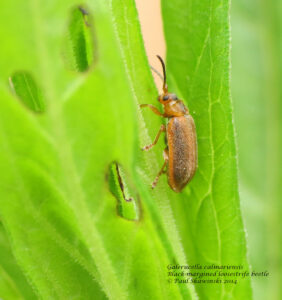Biological Control Methods
Aquatic plant management: biological control methods
Aquatic plants are an important part of a healthy lake. Water plants are food and home for fish and wildlife. They also help stabilize soil, and help prevent shoreline erosion. Some aquatic plants are considered invasive and may cause problems. At other times, native submerged aquatic vegetation may become a nuisance. If a lake management service provider says a treatment of aquatic weeds is needed (see “Management Plans” page), there are options for lake weed control strategies. These include biological, chemical/herbicide, and physical/mechanical methods (the last two have separate pages).
 What is biological control?
What is biological control?
Biological control of aquatic plants introduces a biocontrol agent (usually an insect that eats the invasive aquatic plant). It is put into an area to reduce invasive aquatic plants. The biocontrol agent is identified based on its selectivity (it only eats a certain lake weed). A well-known example is the native milfoil weevil (Euhrychhiopsis lecontei) that can control Eurasian watermilfoil in some situations (see “Eurasian and hybrid watermilfoils” page for more information).
Herbivorous fish like grass carp have been used to reduce growth of lake plants, pond weeds, etc. However, since grass carp feed on many types of water plants, including beneficial native aquatic plants, they are not allowed by the majority of Great Lakes jurisdictions.
Benefits and drawback of biological control
Biological control can be a more eco-friendly lake management option. The control agent is highly-selective to the target species. No aquatic herbicides are used in biological control. Some biocontrol agents can last for multiple seasons, and can sometimes have long-term positive effects.
A drawback is that biological control for water weeds may take years to work. It may also be more effective in some lakes or years compared to others. Some lakes will have large reductions in the invasive aquatic plant populations, while others won't. Biological control may be effective long-term when used with short-term mechanical or chemical control options. Finally, most biocontrol agents need restocking to reduce the invasive lake plants. Finding biocontrol agents may be difficult, depending on the species. The process of finding a species and testing it can be time-consuming — even 10+ years.
How to conduct biological control?
For invasive aquatic plants in the Great Lakes, the only two species that have established biological control options are purple loosestrife and Eurasian watermilfoil. If this option is desirable to your lake, talk with your lake management service provider or state agency (e.g., Wisconsin DNR). They may be able to provide guidance on how to source and release the biocontrol agents. For additional information on biological control for Eurasian watermilfoil, please see the “Eurasian and hybrid watermilfoil” fact sheet. The cost of biological control strategies varies based on species, area, and the number of treatments.